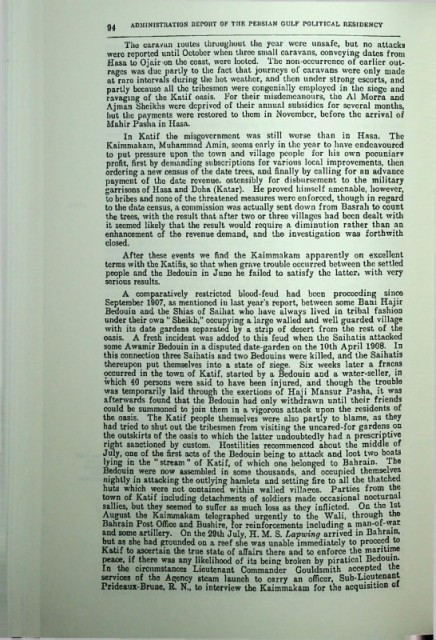Page 396 - PERSIAN 5 1905_1911
P. 396
ADMINISTRATION REPORT OF TIIE PERSIAN GULF POLITICAL RESIDENCY
94
The caravan routes throughout the year were unsafe, but no attacks
were reported until October when three small caravans, conveying dates from
Hosa to Ojair on the coast, were looted. The non-occurrence of earlier out
rages was due partly to the fact that journeys of caravans were only made
at rare intervals during the hot weather, and then under strong escorts, and
partly because all the tribesmen were congenially employed in the siege and
ravaging of the Katif oasis. Tor their misdemeanours, the A1 Morra and
Ajman Sheikhs were deprived of their annual subsidies for several months,
but the payments were restored to them in November, before the arrival of
Mahir Pasha in Hasa.
In Katif the misgovernment was still worse than in Hasa. The
Kaimmakam, Muhammad Amin, seems early in the year to have endeavoured
to put pressure upon the town and village people for his own pecuniary
profit, first by demanding subscriptions for various local improvements, then
ordering a new census of the date trees, and finally by calling for an advance
payment of tho date revenue, ostensibly for disbursement to the military
garrisons of Hasa and Doha (Katar). He proved himself amenable, however,
to bribes and none of the threatened measures were enforced, though in regard
to the date census, a commission was actually sent down from Basrah to count
the trees, with the result that after two or three villages had been dealt with
it seemed likely that the result would require a diminution rather than an
enhancement of tho revenue demand, and the investigation was forthwith
closed.
After these events we find the Kaimmakara apparently on excellent
terms with the Katifis, so that when grave trouble occurred between the settled
people and the Bedouin in June he failed to satisfy the latter, with very
serious results.
A comparatively restricted blood-feud had been proceeding since
September 1907, as mentioned in last year’s report, between some Bani Hajir
Bedouin and the Shias of Saihat who have always lived in tribal fashion
under their own “ Sheikh,” occupying a large walled and well guarded village
with its date gardens separated by a strip of desert from the rest of the
oasis. A fresh incident was added to this feud when the Saihatis attacked
some Awamir Bedouin in a disputed date-garden on the 10th April 1908. In
this connection three Saihatis and two Bedouins were killed, and the Saihatis
thereupon put themselves into a state of siege. Six weeks later a fracas
occurred in the town of Katif, started by a Bedouin and a water-seller, in
which 40 persons were said to have been injured, and though the trouble
was temporarily laid through the exertions of Haii Mansur Pasha, it was
afterwards found that the Bedouin had only withdrawn until their friends
could be summoned to join them in a vigorous attack upon the residents of
the oasis. The Katif people themselves were also partly to blame, as they
had tried to shut out the tribesmen from visiting the uncared-for gardens on
the outskirts of the oasis to which the latter undoubtedly had a prescriptive
right sanctioned by custom. Hostilities recommenced about the middle of
July, one of the first acts of the Bedouin being to attack and loot two boats
lying in the “stream” of Katif, of which one belonged to Bahrain. The
Bedouin were now assembled in some thousands, ana occupied themselves
nightly in attacking the outlying hamlets and setting fire to all the thatched
huts which were not contained within walled villacres. Parties from the
town of Katif including detachments of soldiers made occasional nocturnal
sallies, but they seemed to suffer as much loss as they inflicted. On the 1st
August the Kairamakam telegraphed urgently to the Wali, through the
Bahrain Post Office and Bushire, for reinforcements including a man-of-war
and some artillery. On the 29th July, H. M. S. Lapwing arrived in Bahrain,
but as she had grounded on a reef she was unable immediately to proceed to
Katif to ascertain the true state of affairs there and to enforce the maritime
peace, if there was any likelihood of its being broken by piratical Bedouin.
In the circumstances Lieutenant Commander Gouldsmith accepted the
services of the Agency steam launch to carry an officer, Sub-Lieutenant.
Prideaux-Brunc, R. N., to interview the Kaimmakam for the acquisition ot

